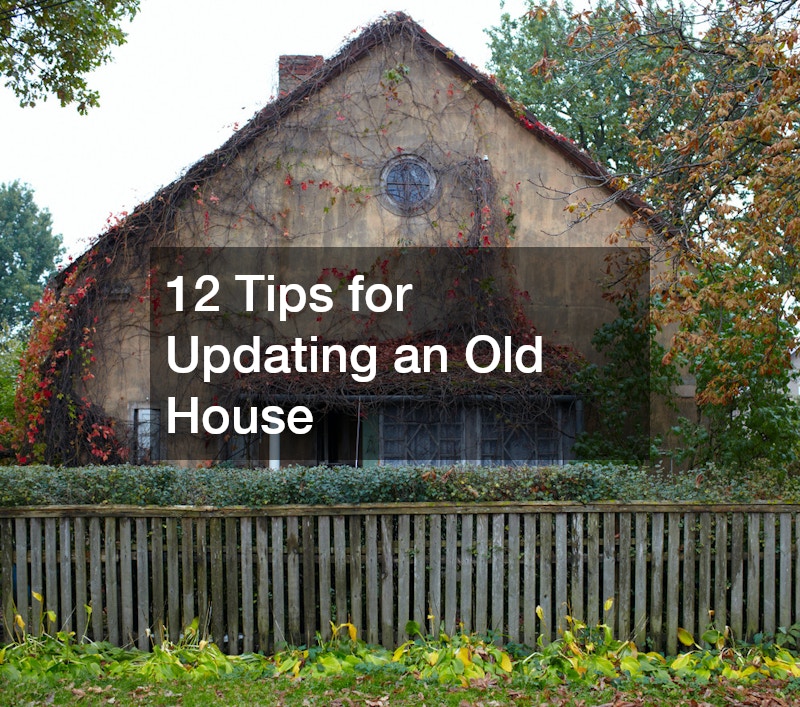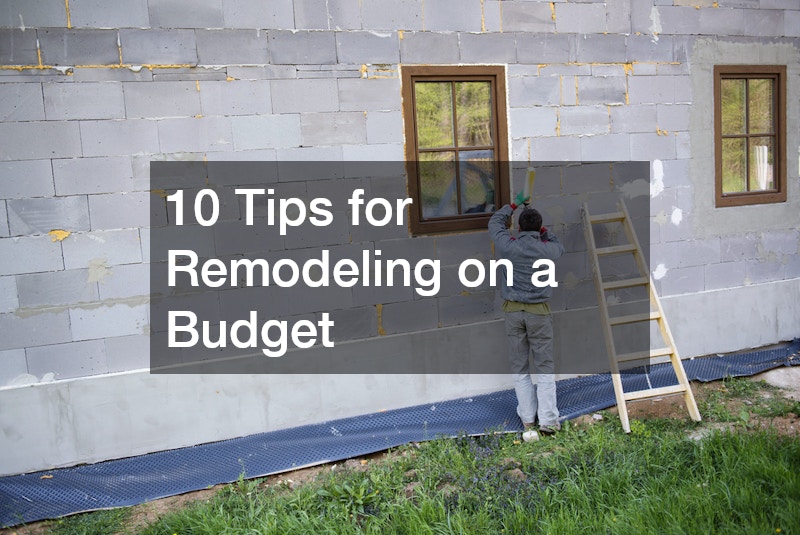
One of the most rewarding parts of renovating an old property is seeing tired, old designs being rejuvenated and refreshed with exciting new elements. Updating an old house can be a project that takes years or even decades, depending on the size of the house, its age, and how much money you want to put into the renovation process. Updating small things like paint on the cabinets or light switch covers will be significantly less expensive than updating the floors or the HVAC system. For all your projects, large and small, you should follow our tips below to contact the right contractors for the job and make your renovation process of an old house as painless as possible.

From calling a professional plumbing company to replace old water supply pipes to planning a pipe remodel that will address old plumbing problems in old homes, there is probably a lot on your list of things to do to make your renovations happen. Before you get too deep in the weeds of panicking about re-plumbing a house or replacing all the air ducts, try to focus on the more manageable projects. This will keep you from spiraling into wondering how it’ll all get done.
Hiring a home remodeling contractor is essential for transforming your space, especially when working with older homes. A skilled contractor can help with structural updates, modernizing interiors, and preserving historic charm while ensuring functionality and safety. A house expert brings valuable knowledge about home construction, materials, and design trends. Whether you’re restoring an old home or upgrading specific areas, their guidance helps homeowners make the best decisions for their renovation projects.
For those who appreciate vintage architecture, old house design embraces classic elements such as intricate moldings, original hardwood floors, and historic facades. Preserving these details while incorporating modern amenities creates a perfect balance between old-world charm and contemporary comfort. Maintaining an aging home requires specialized old house repair services. From fixing foundation issues to updating outdated plumbing and electrical systems, professional repairs help ensure the longevity and safety of an older property. If you’re considering remodeling an old house, careful planning is key. Renovations may involve structural reinforcements, layout modifications, or energy-efficient upgrades while maintaining the home’s original character. Working with experts in historic restoration can help retain the unique charm of an old house while making it more livable for modern needs.
Older houses have a lot of charm to them. There are aspects about them that are unique and reflect the time they were built in. However, this charm could wear out over time. If you have an old house, you may be looking to update it as soon as possible for this reason. You may be itching to make upgrades and add some of your flare so it truly feels like your home.
Updating an old house means you’ll have to dedicate time and money to projects. Most homeowners spent between $5,000 and $10,000 improving their homes in 2018. The updating process may seem overwhelming, but if you take things one step at a time, it’s manageable. Plus, you’ll get an updated home that’s fresh and unique in the process.
So, where do you start? Here are 12 important tips for updating an old house, and why planning your updates is so important for your home, your wallet, and your peace of mind.
Evaluate Your Home
The first step to updating an old house is to evaluate the home itself. What does it look like? Are there areas of the home that need more updating than others? Are you noticing things like dry rot, peeling wallpaper, or chipped paint? Or, are you seeing larger issues, like an older roof or cracked foundation? Knowing the current condition of your home will help you tremendously as you’re updating. You can get an idea of what kind of projects you’ll need to take on and what kind of materials you’ll need for them.
Set Your Budget
An important part of updating an old house is setting a budget. You may have a lot of projects to tackle, but you don’t want to drain your bank account getting them done. Take the time to sit down and plan a budget you can afford for these projects.
Some projects will be more expensive than others. For instance, replacing window shutters is going to be far less expensive than putting in a new septic system for your old house. Putting in new trim is going to be less expensive than replacing the old bathtub in your bathroom. Take the price tag of these projects into consideration while you’re making your budget. If you can, set aside some extra money too in case unexpected expenses come up.
Prioritize Your Projects
Once you set your updating budget, the next thing to do is prioritize your projects. You can divide them into two categories: the must-have updates, and the nice-to-have updates. The must-have projects are the projects that need to get done to properly update your house. An example of this type of project is getting a new roof. If you live in an older home, your roof is likely older as well. If it’s too old, it could be damaged and have cracks in it. This could cause your roof to leak, which means your home is at risk for sustaining water damage. If this is the case for you, call local roofing services to see how they can help with your roofing needs. Other bigger projects to put in the must-have category can include foundation repairs and HVAC system replacement.

The nice-to-have category can include cosmetic projects such as remodeling the kitchen, adding on a new bedroom, or getting double sinks for your bathroom. While these updates are nice, they don’t have to be tackled right away. You can look into doing these projects after your must-have projects are complete.
Know Your Style
A key thing to determine when updating an old house is what style you want your home to have. You may have an older home, but that doesn’t mean your style has to be older, too. You could opt for a more traditional style, or you could go with a more modern look. Or, perhaps you’re interested in a bohemian chic or rustic living style.
The kind of style you want will influence the design of your home. It’ll help you narrow down color schemes, materials to use, and what kind of furniture to get. Your style should reflect who you are and how you want your home to feel. Take as much time as you need to determine what style you like. Being confident in your style choice will help you plan your updating projects better.
Research Your Materials
You’ll spend quite a bit of money on materials throughout the updating process. Do your research on these materials and see where you can get the best deal. For instance, if you want to update your floors, you may be interested in getting hardwood flooring. However, hardwood floors can end up costing you thousands of dollars. If that’s not in your budget, you could get laminate flooring for a lower price. If you’re looking into glass door replacement, check out what kind of glass you want. If you want glass that’s energy-efficient, you may end up paying more for it.
You want to find materials that will last you a while, but also won’t blow your budget. Sometimes, you may have to pick another material instead of your first choice. It’s all about balancing efficiency with cost, so when making decisions on materials, make sure you think about that balance.
Start With The Fundamentals

When updating an old house, start with the fundamental structural aspects. These include the foundation, the roof, and the beams that hold your home up. These may not be the flashiest things to update, but they are the most essential. If they aren’t in good condition, the rest of your house could be at risk. Don’t let all your hard cosmetic work go to waste. Make sure your home’s bones are good, and if they aren’t, update them as soon as you can so you can move on to other updating projects.
Pick Colors That Add Value
An easy way to add color is by painting your home, and it is a great way to update it without spending a fortune. A new coat of paint can make a room feel fresh and revitalized. Choosing the right colors for your rooms can even help add value to your old house. Choosing a neutral color or a lighter blue for your kitchen could help add value, and choosing a pale color for the bathroom could boost value as well.
Remember, the colors you choose for your home should fit the style home you want. If you’re looking for a modern-chic look, you may want to avoid bright colored paint for your walls. Choosing paint that goes with your style will help give your home the ambiance you want to achieve.
Don’t Skip The Lighting
Living in an old house means your lighting situation may not be ideal. Your house could have lighting fixtures that date back to when it was built. If your house was built back in the 1920s, it may have pendant lighting since that style was popular back then. Take the lighting into careful consideration when updating your house. Adding the right lighting fixtures can make your home look bigger and even add value to your home.

When updating the lighting, look for ways to make it more efficient for your home. Look into lights that can save you money on your energy bill each month. You can also look into installing under cabinet lighting to add additional lighting to your home. Before you invest in new lighting, make sure your home is wired properly. If you want to change where certain light fixtures are, you have to make sure your wiring allows you to move them. See what you can do about consulting with an electrical services company to determine if adding or moving light fixtures is possible.
Check Your Windows
You can’t forget to check your windows when updating an old house. If you feel a draft coming from your windows, notice your windows are fogging up a lot, or notice cracks and leaks along the window panes, then it’s time to replace your windows. Depending on how many windows you need to replace, this update could end up costing you thousands of dollars. Not updating them could cost you in the long run, though. You could burn through thousands of dollars in energy bills since your older windows will be letting heat or air escape. This can become especially expensive in the winter when you’re heating your home.
If you replace your windows but still notice your energy bills are through the roof, you may have a bigger heating and cooling issue. Contact a local home heating contractor or HVAC professional to help you figure out what the issue is and how you can fix it.
Fix The Floors
When you’re updating an old house, you should look into fixing up the floors. This is especially important if your floors are warped. Warped floors could be a safety hazard, as they make the floor uneven to walk on. Look into getting warped or bubbled up floors fixed as soon as possible. This could also be a big sign that there’s a leak somewhere underneath your floor, so look out for that as you’re fixing this up.
If you have hardwood floors that are in good shape but could use some TLC, you can refinish them. Refinishing hardwood floors helps you restore them to their former glory. If you have carpeting throughout your old house, pull it up to see what’s underneath. If it’s hardwood flooring, you could pull the carpets up and refinish the wood. Refinishing and updating the floors can add a lot of value to your home, especially if the floors are hardwood.
Replace Older Appliances
When doing updates in your old home, you have to look into replacing your older appliances. Older appliances may not work as well as they should, and this can cause issues if you aren’t careful. For example, an old water heater will make noise when it runs, not produce enough heat for the water, and even leak. These issues may seem small now, but if it breaks on you, you’re suddenly without a hot water heater and have no plan for backup. Replacing older appliances before they break is a great way to prevent any surprise issues from happening. You should also look at your HVAC system, plumbing, oven, refrigerator, and dishwasher to see if they need to be replaced.

You may notice that some appliances and systems are not that old, but still in need of repair. For instance, your air conditioning system may only be a couple years old, but if you run it frequently, it could become damaged quicker. If you notice something is wrong, call an AC repair service to help you get it taken care of. The sooner you can fix appliances, the better.
Don’t Forget The Exterior
When updating an old house, you can’t forget about the exterior. Your house can be fully updated on the inside, but if the outside doesn’t match, it could give off the wrong impression. Plus, your home may look off if the interior and exterior don’t reflect one another.
When updating your house, give the exterior a fresh coat of paint that accents the interior design. You can also look into updating your siding. If you aren’t sure how much that will cut into your budget, you can talk with a company that deals with siding installation and talk numbers with them. The exterior of your home also includes your front lawn. You can update your front lawn by adding a small garden or even putting up lawn decor. These updates can increase your curb appeal.
Updating an old house is a big project to take on. There may be days where you get frustrated with the work and feel like throwing in the towel. However, it’s important to keep your end goal in mind. Picture what your home will look like when it’s all updated. Imagine waking up every morning to an updated home and getting to live your life in it. As long as you keep your goal in mind, you’ll make it through any hurdle that may come up in the updating process.



